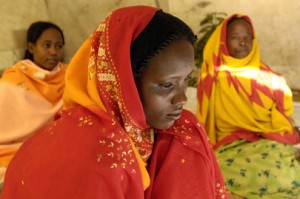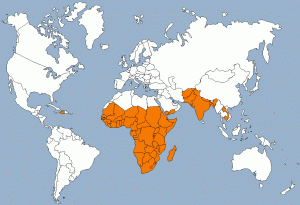Ending the Shame for Women and Girls: The Effort to End Fistula
May 22nd, 2013 | By admin | Category: Reproductive Rights/Women's RightsBy Suzanne York, www.howmany.org
This May 23rd will mark the first-ever International Day to End Obstetric Fistula. This is a treatable condition that sadly afflicts women and girls in developing nations that lack decent maternal care. It is hoped that this problem can finally be dealt with by focusing global attention on it, thereby helping thousands of women and girls in developing countries.
Obstetric fistula is a tear or a hole between a woman’s birth passage and one or more of her internal organs that results in permanent incontinence. It is most often due to prolonged and obstructed labor. The baby almost always dies during labor. For every woman who dies in childbirth, at least ten suffer significant injuries such as fistulas. It is most common in Africa, and in the less developed regions of Asia and Oceania.

Three young women patients wait to check-in for treatment of fistula in Sudan (photo credit: UN Photo/Fred Noy)
Time to End the Tragedy
There are at least two million women living with fistula today, with between 50,000 and 100,000 new cases occurring every year. Some of the main causes are lack of medical care, poverty, having children at a very young age, and poor education.
Although once common in developed countries, it is virtually unknown today, due to the level of obstetric care available to women in the industrialized world.
In wealthier nations, a woman’s lifetime risk of dying from an obstetric complication is low: 1 in 2,800. In poor countries the risk of death is high: 1 in 61. And in Sub-Saharan Africa, it is 1 in 16.
Some of the countries with the highest rates of maternal mortality, and where obstetric risk such as fistulas are common, include Sierra Leone, Afghanistan, Malawi, Angola, Niger, and Tanzania.
It is a debilitating condition, to say the least. Without proper treatment, women with an obstetric fistula can face a lifetime of suffering, unable to control the discharge of urine or fecal matter. Often abandoned by their husbands and families, they find themselves effectively ostracized from society. Girls drop out of school, women cannot work, and worse, some are ignored and discarded by husbands and families, and often left to live a life of isolation.
A Preventable Problem
What is the cost to surgically repair a fistula and end a woman’s agony? The average cost of treatment is $300. This includes surgery, postoperative care and physical rehabilitation. Yes, this misery can be ended, all for less than the price of an iPad.
The need is overwhelming: the international capacity to treat fistula patients has been estimated at just over 14,000 a year — a fraction of the women who develop a fistula each year. Still, when surgery is an option, the success rate is as high as 90 percent.
Other solutions for ending obstetric fistula:
- Postponing marriage and pregnancy for young girls;
- Increasing access to education and family planning services for women and men;
- Providing access to quality medical care for all pregnant women;
- Improving girls’ nutrition to minimize risk of complications during childbirth;
- Addressing emotional damage through counseling and specialized interventions.
Priorities?
Dr. Babtunde Osotimehin, head of the United Nations Population Fund, calls fistula a “failure of health systems to provide accessible and equitable sexual and reproductive health services, including skilled birth attendance and referral to emergency obstetric care.”
The amount of money spent in the erectile dysfunction market is four times greater than the amount spent on maternal and newborn health in poor countries; certainly some funds can be found to end the stigmatizing condition of fistula for women and girls.
Ending poverty, inequality, and lack of access to maternal care must be prioritized by global society. Dr. Osotimehin said, “To end obstetric fistula and fully realize the rights of women and girls, we must address the structural drivers that perpetuate inequalities.” In order for change to happen, the world needs to know about this devastating condition and then pull together the will and resources to end it. Surely this can be done for mothers, wherever they live.
A couple of good places to start and take action to end fistula are Engender Health’s Fistula Care Project and the UN’s Campaign to End Fistula.
Suzanne York is a senior writer with the Institute for Population Studies.


